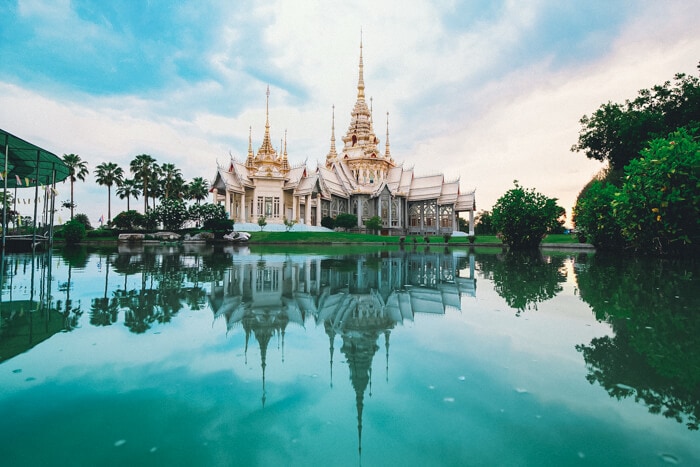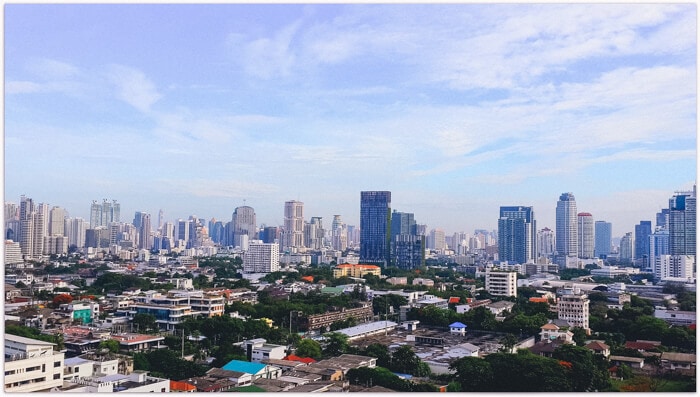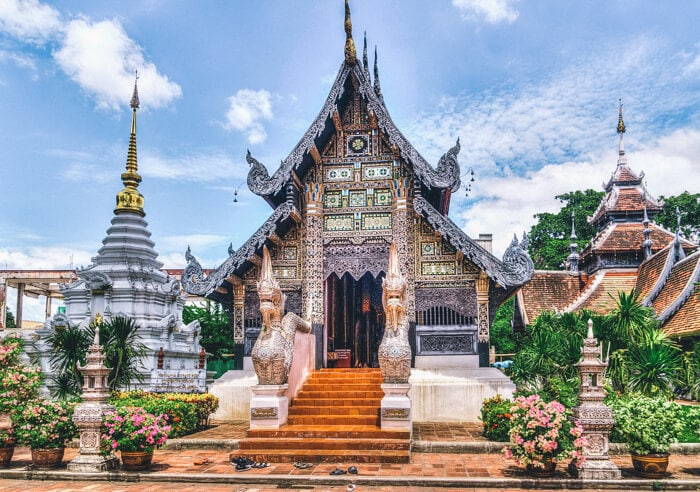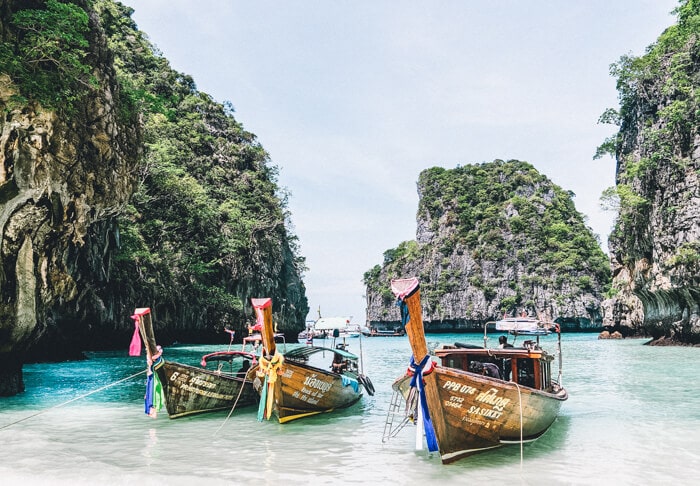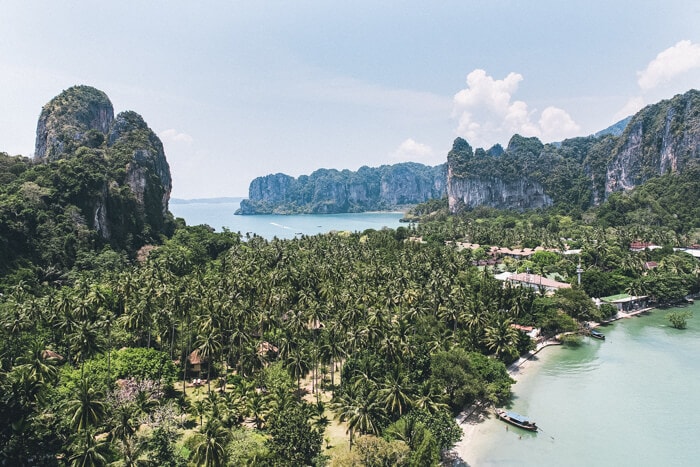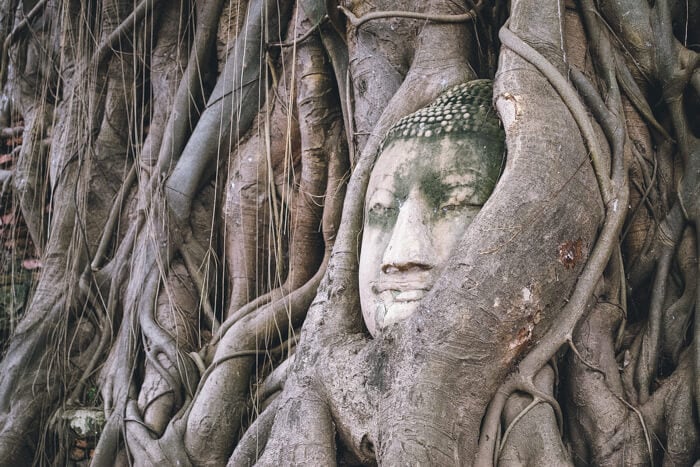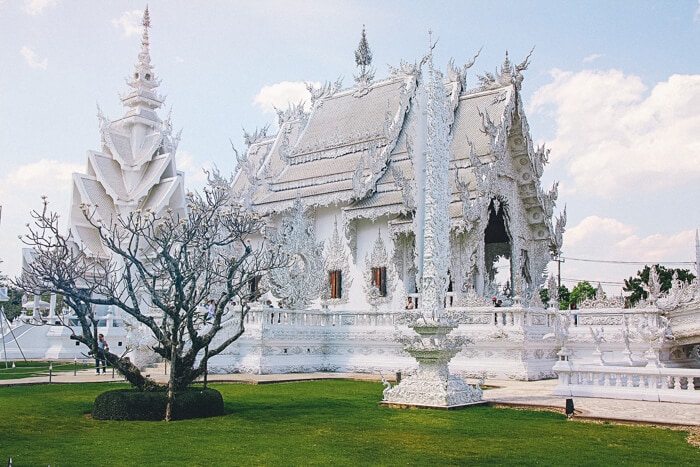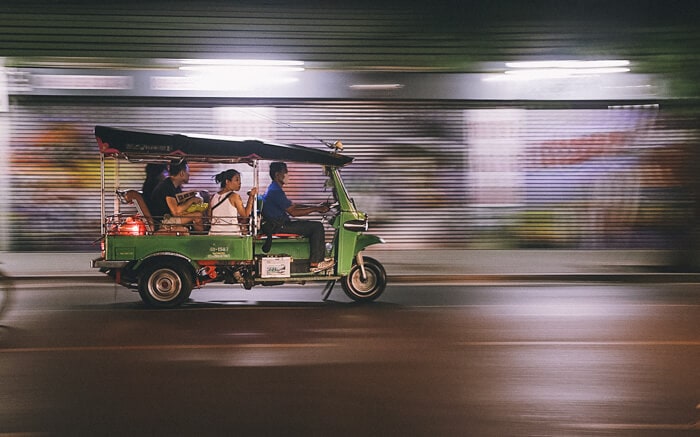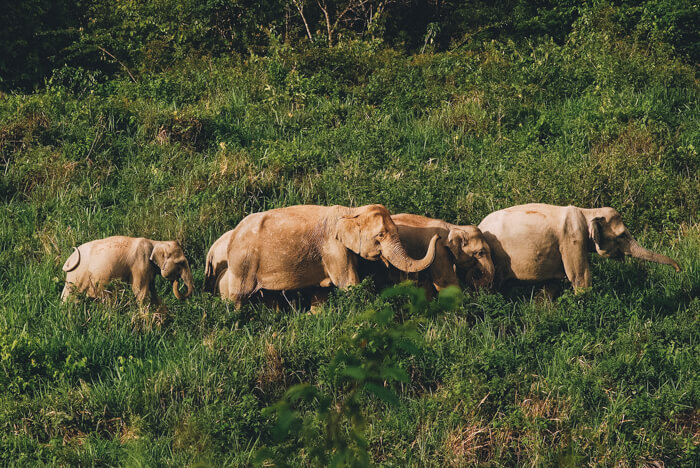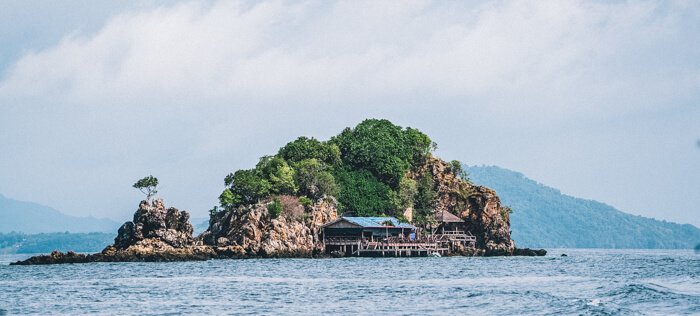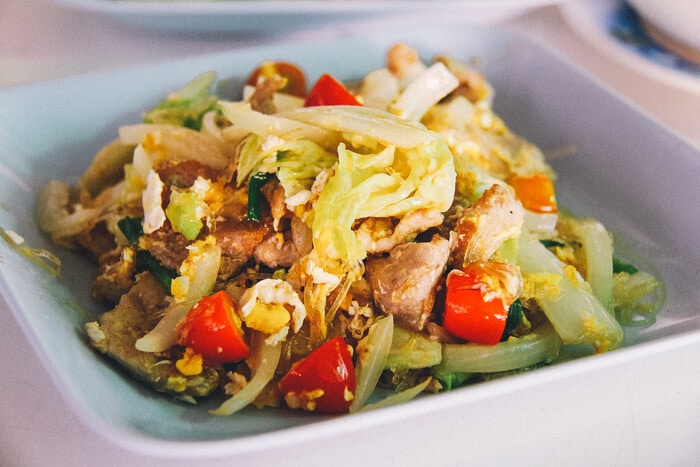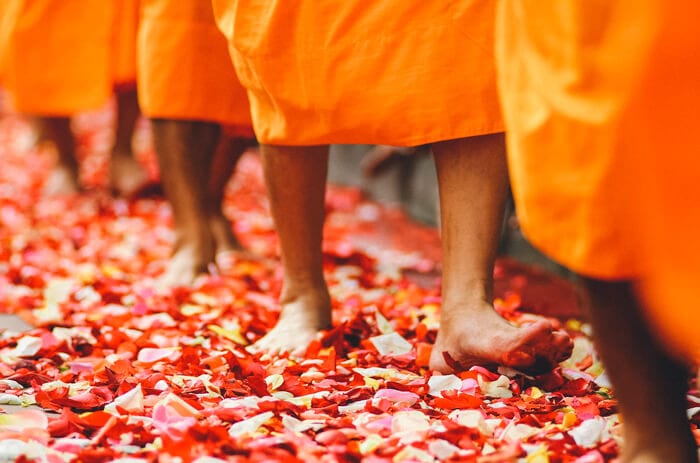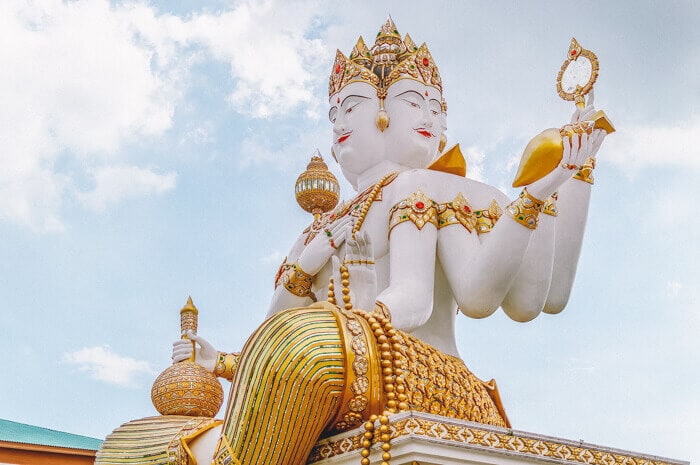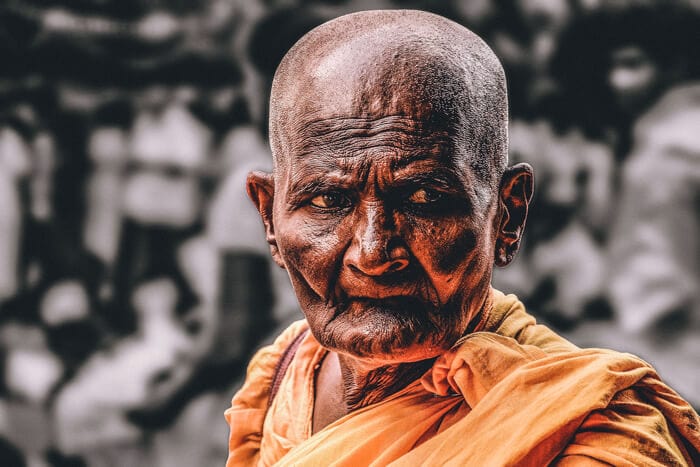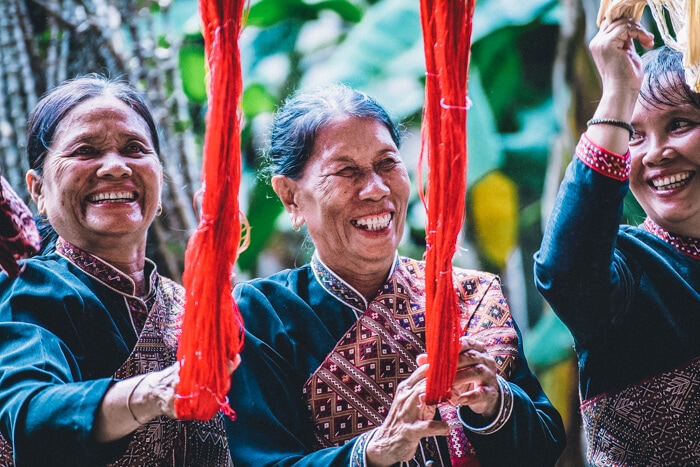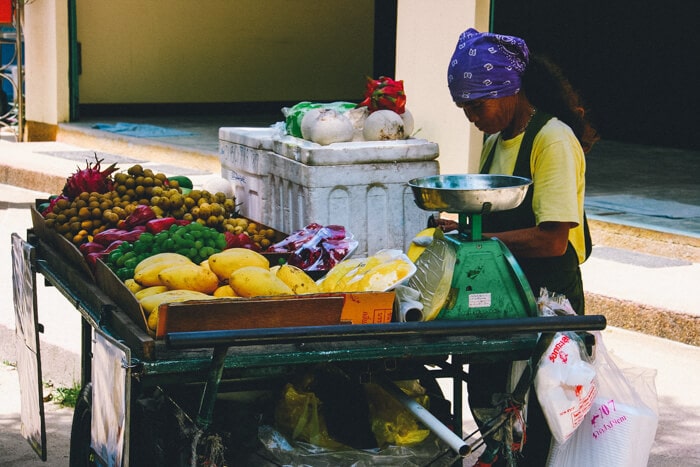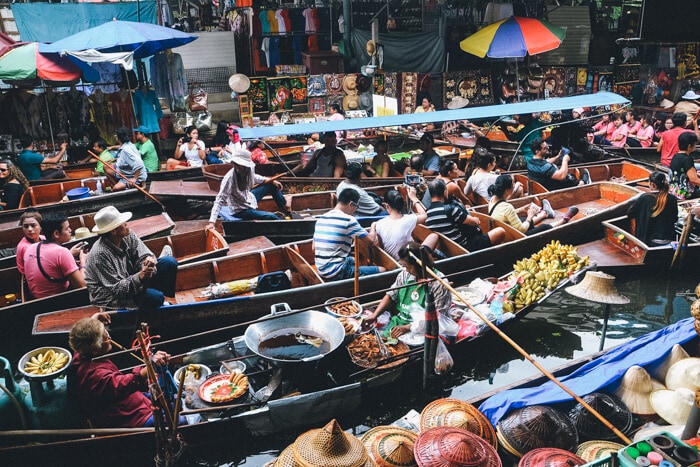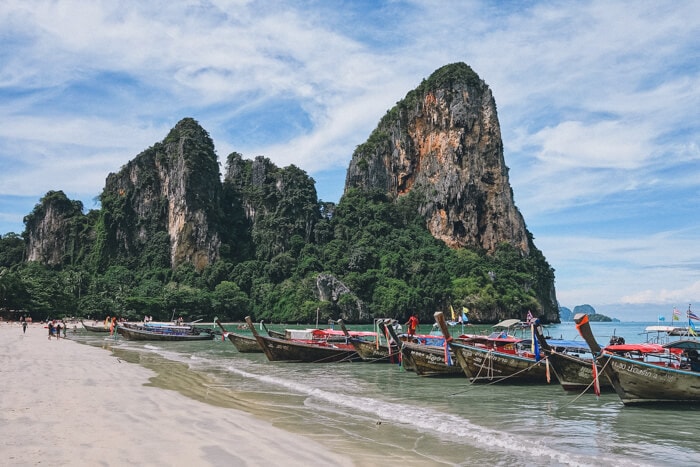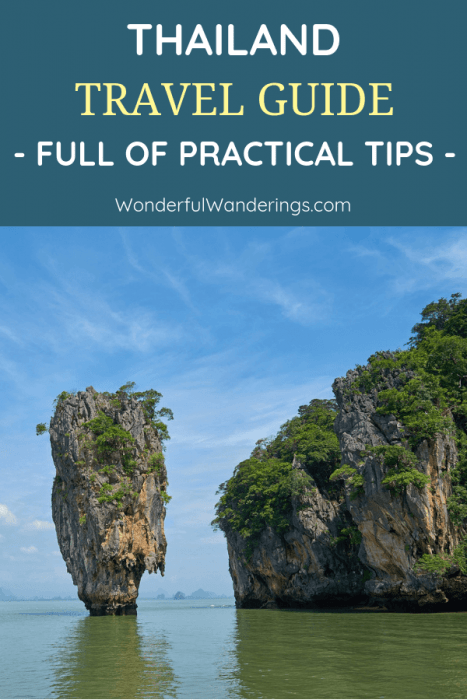Planning a trip to Thailand? Great! The Thailand travel tips below will help you do just that.
Thailand, aka The Land of Smiles, is the 14th largest country in Asia, and one of the most popular tourist destinations in the world. It’s one of the founding members of ASEAN (the Association of South East Asian nations, which dates back to 1967). Thailand shares its borders with Malaysia, Myanmar, Laos, and Cambodia.
There are a number of reasons that Thailand welcomes so many tourists each year – it’s a very diverse country, ranging from the foothills of the Himalayas in the Northern cities of Chiang Mai and Chiang Rai, the metropolis of Bangkok, to white sand beaches and turquoise waters in the south and its islands. All of this is mixed together with incredible cuisine, friendly people, and beautiful Buddhist architecture everywhere.
Contents
- Thailand travel tips: quick facts
- Thailand provinces
- How to travel to Thailand
- How to travel around Thailand
- What to pack for your Thailand vacation
- When to visit Thailand
- What to eat in Thailand
- Famous events in Thailand
- Bank holidays in Thailand
- Cultural customs to be aware of in Thailand
- Places to stay in Thailand
- Don’t forget travel insurance
- Basic phrases and their pronunciation
- Thailand travel safety
- The use of cash and cards in Thailand
- Calling abroad, WiFi and data use in Thailand
- Tipping in Thailand
- A brief history of Thailand
- Posts about Thailand
Thailand travel tips: quick facts
Size: 513,120 km² or 198,115 sq mi
People living there: ~63,000,000
Capital: Bangkok
Governmental structure: The Thai government has a constitutional monarchy, and politics are heavily influenced by the military.
National day: December 5
Time zone: Thailand Time / UTC+7
Currency: Thai baht
Power voltage and socket type(s): 220V, plug types A, B, C, and F. If these don’t match with your devices, make sure to bring a universal adapter.
Official religion(s)/Freedom of religion: Freedom of religion. 93% of the population is Buddhist, followed by Islam and Christianity.
Official language(s) and general knowledge of English: Thai is the official language. English is widely spoken.
Drives on this side: left
International driver’s licence accepted? Yes, and it is necessary for drivers outside of ASEAN countries.
Phone code: +66
Vaccinations needed? None are required but some are recommended depending on the areas you’ll be visiting. Ask your doctor to make sure as many websites will take the safe route and recommend more vaccinations than you’ll actually need, which can become a costly business.
Can you drink the tap water? No
Want more quick facts about Thailand? Check out this post full of interesting Thailand facts.
Thailand provinces
Thailand is split into 77 provinces, with each one having a distinct culture. Listed below are the ones most likely to make up part of your Thailand holiday.
Bangkok
The province where the majority of travelers will touch down, Bangkok is one of the most evocative and exciting cities in Thailand, but also the world, especially for first-time visitors. Hordes of skyscrapers rub shoulders with ancient Buddhist temples. World-class Michelin star restaurants are on the same streets that people are selling 40 baht Pad Thai on the corners. A tantalizing mix of history, ancient religions, and western and Asian culture, Bangkok is one of the world’s truly must-visit cities.
Selected activities in Bangkok:
- 3-hour bicycle tour including a river crossing by ferry
- 2-hour river cruise with dinner and show
- entry to Thailand’s highest observatory deck
Chiang Mai
This laid-back province is home to Thailand’s second-biggest city, Chiang Mai, and is popular with those who want to get out into nature. It offers great trekking through lush forests, past mighty waterfalls, and you’ll even find Thailand’s tallest mountain, Doi Inthanon here. It’s great for trekking, and you can even visit an elephant retirement home there.
Maybe unexpectedly, Chiang Mai is also home to a growing coffee scene. And whether there’s a connection or not, it’s also one of the best places in Thailand for digital nomads. The hype around that has settled down a bit but there are still many digital nomads traveling to Chiang Mai to get some work done and connect with other entrepreneurs while enjoying the very affordable rent and cheap but delicious street food.
Surat Thani
The province of Surat Thani is beautiful, but the main reason many tourists visit Surat Thani is the three islands in the Thai Gulf. Ko Pha Ngan is a hedonist’s paradise, famous for its full moon parties, which are a stark contrast to the many yoga retreats on the island. Ko Tao is scuba diving heaven, and Ko Samui is known for its white sand beaches and turquoise waters.
Phuket
Thailand’s largest island has long been one of the most-visited places in Thailand. It offers something for every kind of tourist. Phuket city on the main island is a hedonist’s dream, with great nightlife, food, and plenty more. However, the island is also home to an elephant sanctuary you can visit and tropical beaches where you can lose yourself and get away from the bright lights and noise of civilization for a little bit. To get the most out of your visit, consider a small group tour of Phuket’s highlights.
Krabi
You’ll know Krabi before you’ve even set foot here. The quintessential Thai image of a long-tailed boat bobbing on turquoise water with a limestone karst cliff in the background? That’s Krabi. Home to Railay Beach, it’s a popular spot for tourists, especially honeymooners. It’s also one of the best places to go in Thailand if you’re an adventure seeker, as Krabi offers great diving, caving, and rock climbing. One of the best day trips to do there is a boat trip to the Phi Phi Islands and if you want to visit the famous James Bond Island, book this early bird tour to avoid the crowds.
Kanchanaburi
The home of the infamous death railway (from the Bridge over the River Kwai), this region welcomes many day-trippers from Bangkok who want to visit this historical relic. There’s more to the region than that though – try camping overnight at Erawan waterfalls to get a slice of nature in this beautiful province.
Ayutthaya
Ayutthaya was the capital until 1767 and now makes for another one of those top places to visit in Thailand. It’s a popular day trip from Bangkok, but it makes more sense to spend a few days getting to know the province. The city’s ransacked ruins are a UNESCO World Heritage site and include the famous image of the Buddha head overgrown by tree roots. Do yourself a favor and skip the Elephant Kraal and the floating market. Both are tourist traps with tasteless animal cruelty on the show.
Chiang Rai
The home of the famed golden triangle, the area where Thailand, Laos, and Myanmar intersect is shedding its brutal past as a notorious drug-smuggling area and is now famed just as much for boat trips on the Mekong, stunning landscapes, and awe-inspiring temples.
Some other notable provinces to visit are Phetchaburi, Nakhon Ratchasima, Mae Hong Son, and Sukhotai. It would be a very long article if we listed something every province has to offer, as they’re all unique and wonderful!
I hope the above has given you an idea of where to go in Thailand. But first, you need to get there.
How to travel to Thailand
Entry requirements
EU and US travelers require a Thailand travel visa or tourist visa to visit Thailand. On arrival, you will be issued with a visa valid for up to 60 days, depending on your entry point to the country. It costs $30. Your passport must have at least 6 months left before expiration when you arrive in the country.
For more information on Thai visas, check out the website of the Thai embassy.
Transportation
Getting to Thailand is easy in general and can be done in several ways:
By bus
Traveling overland to Thailand by bus is relatively straightforward. You can find the most common routes below.
From Cambodia
Notorious for scamming, the Poipet – Aranyaprathet border is the main crossing for travelers coming or returning from Siem Reap and Angkor Wat in Cambodia. Do your research before you cross this border or your Thailand adventure may well start with being scammed!
From Laos
There are 7 border crossings between Thailand and Laos, many of them located on the Mekong river. The most common used by travelers are as follows:
Houay Xai – Chiang Khong (North) – international buses connect Chiang Mai and Chiang Rai with Houay Xai.
Vientiane – Nong Khai – this crossing is used for both and rail and is useful for travelers coming from the Laotian capital.
Pakse – Ubon Ratchathani (South) – this is the best way for travelers who have visited Laos’ Si Phan Don.
From Malaysia
Padang Besar is the main border crossing and is located between Penang and Hat Yai. You can get buses from Kuala Lumpur, Penang, and Butterworth which will use this border crossing. It’s a pretty easy and smooth crossing.
There is another crossing north of the Malaysian city of Kota Bharu. However, it’s a low-level conflict zone, and it’s not recommended.
From Myanmar
Until recently, it was all but impossible to travel to and from Myanmar overland, but changes in recent years mean there are now 4 overland border crossings. The main crossings are in Mae Sot and Mae Hong Son. At the time of writing, there are no international buses and you have to change buses before crossing the border from either side.
By train
From Cambodia
Currently, you can’t travel from Cambodia to Thailand by train. However, when you arrive in Aranyaprathet, you can take a train to Hualamphong station in Bangkok. It takes between 5 and 6 hours.
From Laos
Vientiane – Nong Khai – as well as international buses, it’s possible to cross the border by train. However, you’ll have to get a quick train across the border and then switch to another before heading to your destination in Thailand.
From Malaysia
As of 2016, there are no longer any trains that cross the border, but it is possible to change trains here. This is because the system on the Malaysian side was upgraded.
By ferry
from Malaysia
You can cross the Malaysia – Thailand border between Langkwai and Ko Lipe on the West Coast. From Ko Lipe, you can take the ferry to other Thai islands such as Ko Lanta and Phuket.
Look here for ferry routes and prices to Thailand.
By plane
Unless you’re already in one of the neighboring countries, you’ll probably start your holiday in Thailand at one of the country’s five international airports.
Bangkok’s Suvarnabhumi airport is a huge international hub and is the starting point for many tourists traveling not only to Thailand but also to the rest of South East Asia. There are direct flights available to many global destinations.
Chiang Mai is the best place to fly into Thailand if you want to visit the north, whereas Phuket is convenient for those visiting the south and the islands.
It’s easy to find domestic flights from Bangkok Suvarnabhumi or Don Mueang to almost all of Thailand’s 76 provinces.
Check Skyscanner for a handy overview of your flight options and prices.
How to travel around Thailand
Getting around Thailand independently
It’s quite easy to explore Thailand by yourself and there’s a lot of information online for the best ways to travel within Thailand. Most bus and train companies allow you to buy tickets online, and websites are in English. However, there are a few things to bear in mind.
Thailand’s roads are considered the second most dangerous in the world, so if possible, use the train or flights. If you rent a car or scooter, you should be very confident in your driving abilities. Scooters aren’t a viable option for long trips.
It’s inexpensive to travel in Thailand. A great way to compare prices and modes of transport is by using the website 12go.asia.
What to pack for your Thailand vacation
Unlike in Europe, Thailand has three seasons rather than four. The hot season runs from March until June, the wet season (also called monsoon season) varies depending on location. Officially, it runs from June until October. The cool season is from November until the end of February.
What to pack for Thailand in the hot, wet, and cool seasons
- Flip flops (you have to take your shoes off a LOT in Thailand)
- Hiking shoes/boots
- A refillable water bottle
- A converter plug
- Bug spray
- Suncream
- Swimwear
- A microfibre towel
- Shawl/scarf (to cover shoulders when visiting temples)
- Light, cotton trousers
- A sturdy backpack
- A raincover for said sturdy backpack (especially in the wet and cool seasons)
- A rain jacket and waterproof hiking pants (especially in the wet and cool seasons)
- A sweater or sweatshirt. It can get cold at night, especially in the Northern provinces like Chiang Mai and Chiang Rai
- An old book. Many hostels have good book exchanges where you can swap after you’ve finished.
Kindle - A travel pillow for long bus rides. This is my favorite one.
When to visit Thailand
There’s no bad time of year to visit Thailand. For European or American tourists who are used to a milder climate, it may be a better idea to visit in the cool season, where the humidity isn’t quite as stifling, and the rain takes 20 seconds to soak through to your bones rather than 10.
The west and east coasts of southern Thailand have differing climates. For islands and cities on the West Coast and the Andaman Sea (eg Phuket, Ko Phi Phi, Ko Lanta), the best times to visit are between November and May, whereas the islands off the east coast in the Gulf of Thailand (Ko Samui, Pha Ngan, Tao) are better to travel to from April to October.
What to eat in Thailand
Yes, there are plenty of things to see in Thailand, but there’s also so much to eat. Give the following dishes a go.
Pad Thai
Thailand’s take on stir-fried noodles is one of the country’s most famous exports. This delicious dish, made with shrimp or chicken is available on almost every street corner and is a cheap, filling dish that you’ll go back for again and again. Vegetarians can enjoy Pad Thai with tofu.
Pad Sii Eiw
Less well known abroad, but just as good, this delicious dish is made with thick rice noodles, dark soy sauce, as well as Chinese broccoli and cabbage. It’s a good starter dish for those new to Thai food, as it’s not spicy. However, you can add chilli flakes if your tastes are a little hotter.
Tom Yum (Spicy Shrimp Soup)
This aromatic soup is one of the most popular dishes in the country, and rightly so. The dish includes traditional Thai ingredients such as kaffir lime leaves, galangal, and lemongrass amongst other. Then, fresh mushrooms and shrimps are added. There’s an option to add coconut cream if you’d like the thicker version.
Som Tam (Spicy Papaya Salad)
A great dish to cool you down on a hot day, spicy papaya salad is a medley of fresh ingredients mixed together in a mortar and pestle, including green papaya, peanuts, tomatoes, carrots, peanuts, and of course the secret of every Thai meal, fish sauce. Although it originated in northeastern Thailand, it’s popular throughout the country and there are many variations on it.
Pak Boong (Fried Morning Glory)
Pak Boong is a tasty spinach like vegetable which you can find in kitchens all over the country. Chefs usually use soy sauce, garlic, soybean paste and of course chillis as a seasoning, before frying it until it’s so hot that flames come off it. Morning glory covers every corner of the Thai palette, as it’s salty, sweet, crunchy, and spicy. Although it’s most commonly prepared with oyster sauce, vegetarians can enjoy this dish without it.
Kai Med Ma Muang (Chicken with Cashew Nuts)
This sweet chicken dish is complimented by cashew nuts and whatever vegetables are available in the kitchen that day. The tasty combination is loved by both Thais and foreigners alike.
Thai Red/Green/Yellow Curry
Another of Thailand’s most famous exports, whether you’re eating a red, green, or yellow curry will generally depend on the region that you’re in. Curry paste is made in a pestle and mortar from a range of quintessential Thai ingredients before meat or vegetables are fried in the paste, before adding coconut milk. Red is the spiciest of the three.
Massaman Curry
A milder curry originating in the south of the country, Massaman is a delicious dish usually made with chicken or beef, potatoes, peanuts and a mixture of curry pastes and coconut milk. The tenderly cooked meat mixed with a rich variety of flavors makes this one of the best curries in the whole of Asia.
Khao Pad (Fried Rice)
Another Thai favorite – simple fried rice. It is pretty much just egg fried rice with onions, and if you’re lucky some cucumber on the side to garnish it. It’s a much-loved dish here though, and a go to. Much like sandwiches in the UK or a baguette in France. It’s normally served alone, but you can order it as a side dish in most restaurants too.
Mango and Sticky Rice
This popular Thai dessert is famous throughout the country. Slices of mango and sticky white rice are served with lashings of condensed milk to make a delicious sweet treat.
Famous events in Thailand
Water Festival (Songkran) – Everywhere
More of a 3-day water fight than a festival, Songkran is celebrated throughout the whole of the country and you won’t be able to avoid it if you’re in Thailand between the 13th and 15th April! It marks the start of the Thai new year and has involved from a Buddhist ritual of sprinkling a little water for purification to people using water guns, buckets, hosepipes, water bombs, and basically anything they can get a hold of to drench other people. It’s a lot terrorizenbsp;
Monkey Festival – Lopburi
Lopburi is an unusual town. Humans aren’t in charge here – that would be the roughly 3,000 wild macaques that overrun the ancient ruins, steal food, and generally terrorise the local residents. However, each year, humans and monkeys come together for the Lopburi monkey banquet festival, where the town’s simian residents can enjoy over 4,000 tonnes of fruit and vegetables.
Vegetarian Festival – Phuket
Those who come here expecting a delicious food festival full of meat free dishes might be in for a bit of a shock. One of the most unusual events in the lunar calendar, the Vegetarian Festival is an event that originated in the Chinese community of the city. Things like razor blade ladder climbing and fire walking make for an interesting festival, that can be hard to watch at times.
Read more about the Vegetarian festival here.
Chinese New Year – Everywhere
Celebrated mostly in big cities such as Bangkok, Chiang Mai, and Phuket, Chinese New Year is an important celebration in the lunar calendar, and one of the earliest in the Gregorian calendar year, as it falls in February. Look out for dancing dragons, delicious Chinese and Thai fusion street food, and exploding firecrackers. The best place to enjoy Chinese New Year is Bangkok’s vibrant Chinatown.
National Thai Elephant Day – Everywhere
On March 13th every year, Thais celebrate their national symbol – the elephant. In zoos and elephant parks and zoos across the country, these amazing creatures are treated to banquets of sugar cane and fruit. There are also Buddhist ceremonies in some places, to bring good luck to the elephants and their handlers (mahouts).
Loy Krathong, Festival of Light – Everywhere
Thought to have originated in the ancient capital Sukhothai in the 13th or 14th century, Loy Krathong is arguably one of the most beautiful festivals in Thailand. Loy Krathong involves small baskets or rafts, usually made of banana leaves, filled with incense and candles and set to float away down the river. Basket makers also put a small hair or fingernail clippings in the baskets, with an offering of some coins. This act is said to alleviate bad luck and give a fresh start.
Candle Festival – Ubon Ratchathani
Taking place ron a sacred Buddhist holiday, the candle festival in Ubon Ratchathani is one of Thailand’s more sedate festivals, but definitely worth visiting. Teams of international artists come together to create wax sculptures inspired by traditional art and modern, abstract works. If you want to drink during this festival, stock up the night before as you can’t buy alcohol on Buddhist holidays. However, if you want to drink, be respectful.
Lantern Festival – Chiang Mai
Up there with Loy Krathong as a contender for Thailand’s most beautiful festival, Chiang Mai’s lantern festival is held every November. There are parades, religious ceremonies, and fireworks, but the key event is the releasing of the paper lanterns into the sky, which is said to bring you good fortune as they float away on the evening breeze. The lantern festival is famous throughout Thailand, so if you want to book a hotel close to the action on the river, you’ll need to do it well in advance.
Mother’s Day/Father’s Day – Everywhere
Thai Mother’s and Father’s Day are celebrating on the birthdays of the Queen (13th August) and King (5th December) respectively. These are a step up from the equivalent days in Europe, and it’s extremely emotional. Children honor their parents and vice versa. Most schools across the country prepare ceremonies on both days, and an integral part is making offerings to Buddhist Monks. Children create gifts and cards for their parents, an especially popular one being jasmine on Mother’s Day.
Bun Bang Fai Rocket Festival, Issan
One of Thailand’s more unusual celebrations, the Bun Bang Fai Rocket Festival takes place in the north-eastern region of Isaan every May, in order to herald the start of the rice planting season. Farmers compete against each other to launch the most elaborate rockets, said to encourage the gods to send down rains to make the crops grow big and strong. If you overdo your rocket and it fails to launch, the punishment is being thrown in a mudbath.
Bank holidays in Thailand
The following public holidays in Thailand may change from year to year, depending on the lunar calendar, or if they fall on a weekend. (*) Businesses mostly close on these days. Bars and shops may be open, but on Buddhist holidays, it’s against the law to serve alcohol.
- 1st March – Makhi Bucha day*
- 12th – 16thApril – Songkran (Thai New Year)
- 1st May – Labour Day *
- 14th May – Royal Ploughing Ceremony
- 29th May – Visakha Bucha Day*
- 27th July – Asahna Bucha Day*
- 27th July – Buddhist Lent
- 12th August – Mother’s Day
- 13th August – Queen’s birthday*
- 15th October – passing of King Bhumibol*
- 23rd October – Chulalongkorn Day*
- 5th December – Father’s Day
- 10th December – Constitution Day
Cultural customs to be aware of in Thailand
There are a few cultural customs for tourists to be aware of in Thailand, as you could get into trouble if you fail to observe them.
The Thai Wai
The Thai Wai is a greeting, equivalent to a handshake in British culture, or kissing on the cheek in some European countries. It consists of putting your hands together in a prayer motion and bowing. The deeper the bow, the more respect you are showing. A deep bow should be reserved for elders.
Body parts
According to Buddhist customs, the head is the most prized body part. Touching someone on the head is offensive. At the other end of the scale, the feet are considered as the lowest body part. Remove your shoes before entering someone’s home, and don’t show the soles of your feet wherever possible (obviously sunbathing on a beach it’s fine).
The Royal Family
Never insult the Royal Family. Serious cases can result in 15 years in prison. The national anthem is played before sports events and during cinema screenings, and you should always stand for it.
Monks
In Buddhism, Monks are forbidden from touching women, or taken anything that they offer them. It’s a good idea for both men and women to keep a respectful distance from Monks when they encounter them in public.
Ladyboys
The ladyboy is seen as the third gender in Thailand, and there’s a lot more to it than the representation we see in the West. You will see ladyboys everywhere, not just in cabaret shows. It goes without saying – treat them as you would anybody else, and don’t ask personal questions.
Places to stay in Thailand
Agoda is the booking site for finding accommodation around Southeast Asia and that goes for Thailand as well. Start your search here.
Don’t forget travel insurance
No matter how well you plan and research a trip, there are always things that happen beyond your control. Something might get canceled, you can get ill or hurt while traveling or one of your electronics might break or get stolen. When misfortune strikes, travel insurance has got you covered. I’ve had ongoing travel insurance ever since I started traveling to make sure I’m covered for every trip I go on. Don’t have insurance yet? You can get a free quote here:
Basic phrases and their pronunciation
Firstly, and most importantly, many of these phrases will change depending on whether you are addressing a male or a female. If you are addressing a male, the ending is ‘krap’ and for a female, it’s ‘ka.’
How are you?
Goodbye
Please
Thank you
Sorry
Yes
No
Excuse me
I don’t speak Thai
What is your name?
My name is … (man)
My name is … (woman)
How much?
Can you help?
Where is the toilet?
Do you use the meter? (for Bangkok!)
Vegetarian
Not spicy
Really spicy
Delicious
Cheers!
Sabaaidii mai?
Bai/La gorn
Pord
Khop Kun
Khot hort
Chai
Mai
Kortoot
Chăn poot tai mai bpen
Kun chuu aria?
Pom chuu …
Chan chuu …
Taorai?
Choo ay dai mai?
Hong nam yoo tee nai?
Chai meter mai?
Mawng sa vee rat
Mai Phet
Phet mak
Aroy
Chon gaêw!
Thailand travel safety
Crime
Thailand is generally a safe country for tourists, provided that you use common sense when travelling there. Violent crimes, such as robbery, are extremely rare but you should always be on your guard for low level crimes such as pickpocketing. There are also a number of scams in Thailand.
A particularly common one is smartly dressed men coming up to you in Bangkok and offering to sell you a bus ticket to one of the southern destinations and a price that seems too good to be true. Well, it is. More often than not, while you’re sleeping on the long, overnight bus journey, your bag is being opened in the bus’s hold and your valuables are being taken out.
The areas where you should be most on your guard are unsurprisingly the areas with the most tourists. Exercise caution in Bangkok, Pattaya, Phuket, and the islands in the Thai Gulf and Andaman Sea.
Travel
The biggest concern in Thailand when it comes to Thailand is the roads. They are statistically the 2nd most dangerous in the world, and if it’s possible to take a train or a plane over a bus, it’s probably a better option.
In tourist areas, don’t be tempted to get a scooter or a quad bike after a few beers – especially if you’re not used to riding a vehicle like this at home. Not only will you be heavily penalised if you damage the vehicle, you are putting yourself in great danger.
Natural Disasters
The most common natural disaster that is likely to affect your trip is a storm. In the monsoon season, these are commonplace and cause flash flooding and landslides. They’re more likely to be an inconvenience on your travels than cause you any physical harm. Just be sensible – stay away from caves and waterfalls during this seasion.
The use of cash and cards in Thailand
Thailand is still very much a cash-based society. Exchange rates on Thai baht are better when you’re in the country, so exchange at the airport when you arrive, or withdraw at a cash machine there.
Although cash machines are available in even the smallest villages, they’re expensive. Foreign cards are often charged 200 baht (over €5), no matter the amount of the transaction. Therefore, it’s better to get big sums out and store them somewhere safe while travelling.
ATMs in large shopping malls and supermarkets charge 150 baht – still expensive but will make a difference over multiple withdrawals. It’s best not to convert into your home currency, as this will shave 5-7% off the conversion fee.
Calling abroad, WiFi and data use in Thailand
As I have a Belgian/European SIM card, I would normally pay roaming charges when calling, texting, or using data in Thailand. To get around this, I use the Solis mobile hotspot by Solis Wifi and buy day passes for the duration of my trip.
Aside from day passes, Solis Wifi also offers monthly prescriptions providing you with 4G throughout your trips. I’ve been using their daily passes not just when I travel outside the EU (no roaming charges for me in the EU) but also as a backup for when I think I’ll go over my phone’s data plan.
Check out Solis Wifi here.
Tipping in Thailand
Tipping isn’t mandatory in Thailand but in many cases, it’s appreciated. What you tip depends on the situation but you should never leave just one baht as it’s considered an insult. You can find more information on who to tip what in Thailand here.
A brief history of Thailand
Humans are thought to have first inhabited Thailand more than 40,000 years ago, which we know from stone artefacts found in the province of Mae Hong Son in the north west of the country. In early Thailand, like most of south east Asia, Indian and Hindu influences were rooted quite strongly in the culture, some of which you can still see today.
Khmer Influence
During the 9th – 11th century, the Dvaravati people, a Mon culture, inhabited Thailand. Although they had heavy influence on art, language and religion, they did not have any political power. You can see Khmer influenced architecture especially in the north and east of the country, where many temples have been restored to former glories.
Lanna Era
The Lanna people inhabited the northern cities such as Chiang Rai and Chiang Mai from the 13th – 15th century. Their main contributions to Thai culture were art and literature in their 200 year empire.
Sukhothai Era
While the Lanna empire controlled the north of Thailand, in the 13th century the Sukhothai Kingdom ruled most of what we now know as Thailand, down to the Chao Phraya river basin. It also ruled over some areas of Laos and Malaysia. Nowadays you can visit the city of Sukhothai in central Thailand, a UNESCO World Heritage site where the ruins of the old capital are still very much intact.
Ayutthaya Era
Another UNESCO World Heritage site situated on the Chao Phraya river, you can visit in modern day Thailand, Ayutthaya was the seat of power in what was known as ‘Siam’ between 1351 and 1767. Many wats (temples) were used as centres of learning, and Ayutthaya even conquered Angkor and the Khmer people. It was one of the most powerful dynasties that south east Asia has ever seen.
In the 18th century, the city was destroyed by the Burmese, who razed it to the ground and set it on fire. The ruins are one of Thailand’s most popular historical destinations nowadays.
Rattanakosin Era
In this era, Thailand covered some of Burma, all of Laos, and a little of Cambodia and Malaysia. It’s also when the capital was moved to the modern-day capital of Bangkok, although King Rama I did also restore Ayutthaya as much as was possible after the sacking by the Burmese. This era is when Thailand started to establish relations with Europe and the USA, and railways, roads, and post offices started to be built. During this period, football and surnames were also introduced to the country.
Second World War
Thailand had adopted a position of neutrality in World War II, until the Japanese invasion in December 1941. Fighting lasted only 5 hours before a ceasefire was agreed. During the 4-year occupation, the infamous Siam – Burma (aka death) railway was constructed, with over 100,000 people, both civilians and allied troops dying during the process.
Modern Day
Nowadays, Thailand is a constitutional monarchy which has a strong military influence over politics in the country. Over 63,000,000 people live here. Tourism is one of the primary industries and Thailand is currently ranked as the most visited country in Asia, and the 7th in the entire world, welcoming over 32.6 million tourists each year who come to visit the many tourist sites in Thailand, discover the culture, enjoy the nature and/or party.
And that’s it! I hope these Thailand travel tips have given you an idea of where to go and what to do in Thailand. If you plan a trip to Thailand, let me now how it goes!
Posts about Thailand
Click here for all the posts about Thailand.
PIN FOR LATER
This page may contains affiliate links. If you book anything through these links, I’ll earn a small commission at no extra cost to you.

